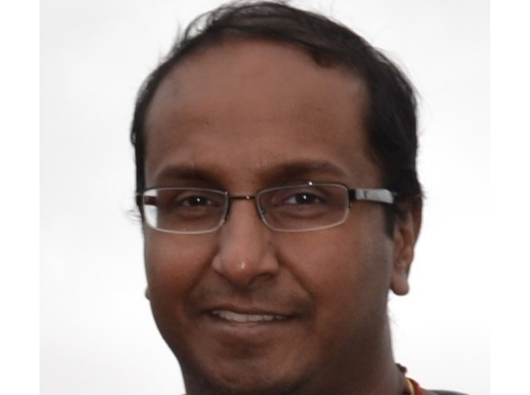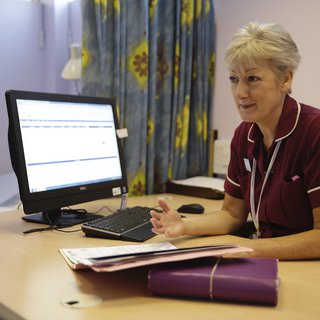"I am incredibly happy to be alive and I am glad I took part [in the clinical trial]"
When Shibu was diagnosed with blood cancer in 2006, cord blood transplants were a 'new concept'. After struggling to find a bone marrow donor, Shibu was offered a place on a trial where he'd receive a cord blood transplant. Here's how it went.
Meet Shibu
Shibu was 42 years old when he was diagnosed with acute lymphoblastic leukaemia. This was in 2006, and he had just moved to the UK from India.
Here, he explains what led him to take part in a clinical trial, the challenges he faced, and how he benefited.

I had moved from India to the UK for work and had been living there for a year before I was joined by my wife and baby daughter. It was soon after being reunited with them that I got the shocking news of my diagnosis.
The day after my diagnosis, I was transferred to Barts Hospital in London for initial treatment. But as we were new to the country and did not know anyone else in the UK, we returned to India so I could get further treatment there. I went into remission in 2007.
We came back to the UK and I was taking imatinib to suppress the cancer, but in 2010, it returned. I had chemotherapy, but that was not successful, and I was told that my only option was to have a bone marrow transplant.
None of my relatives were a match, not even a 50% match.
There were not many donors from the Asian community and a match couldn’t be found there either, so it seemed that I had run out of options.
But then came an unexpected opportunity...
I was given the choice of palliative care or further chemotherapy, but then my doctor discussed a new cord blood transplant trial with me. These transplants had been successful in children, where only one cord is needed. However, for adults, you need two and these could come from unrelated donors.
The doctors explained that I had a better chance of finding a cord blood match than a bone marrow match, as the compatibility criteria is lower.
It was a new concept. The treatment had only been used at one other London hospital and there was little data about it. But the information we were given was clear and my wife wrote everything down.
We signed some forms to say we understood the risks and what was involved and began the process.
At that time, we did not have any other choices, and we accepted whatever was thrown at us. I was scared but I did not have an alternative. My desire to survive made the decision easy to make.
Taking part in the clinical trial
Before the trial, I was admitted to hospital for radiotherapy on my whole body. I was also given medicine for a month to reduce my immunity, otherwise my body would have rejected the cord blood.
On the day of the trial, the specialist nurse injected the fluids while the doctor observed. I was looked after by the same clinical nurse specialist throughout, and the doctors were highly supportive.
They were always consulting and visiting me, guiding me where to find further help and provided me with sick notes for work. I could text my clinical nurse specialist and she would quickly respond.
My road to recovery
I thought I’d be able to go back to work in a month, but just as I was due to return, I found I couldn’t go to the toilet – a clot was blocking my urinary tract and I had to spend time in hospital. I also experienced a clot on my brain, difficulties with my lungs which led to pneumonia, and I had heart and joint problems.
It’s thought that these were side effects of the chemotherapy and steroids. I now take around six tablets daily and will need surgery on my hip in a few years.
Considering the options
I was asked if I would speak to a lady who had been offered the same trial following my experience. My advice to her was to go through all the options and decide. The doctors have the best information, so listen to them, and get a second opinion if possible.
If a trial is likely to have a better outcome, then go for it. Do not lose faith and be strong. You do not know what’s going to happen, but sometimes you have to take a risk.
I know that for some communities, language can be a barrier. Translation services can be patchy, and although there are leaflets in different languages, it would be helpful if everything was explained and translated at every single stage.
Travel and finances are also an issue. Not every hospital offers the services people need, so travel and overnight stays can be necessary. That can put people off or they may not be able to afford it.
But for me, the clinical trial was the only choice at that time. I am incredibly happy to be alive and I am glad I took part.
Since Shibu took part in this clinical trial in 2006, cord blood transplants have become a common treatment option for people with blood cancer. Especially those who are unlikely to be cured by chemotherapy alone, and those who cannot find a suitable stem cell transplant.
It is vital that everyone has access to clinical trials, and that they are representative of ethnic diversity. To find out what we're doing to increase the number of people from minority ethnic backgrounds taking part in clinical trials, please read our report below.

Contact our Clinical Trials Support Service
Get personalised support to understand which clinical trials are available - whether you're a patient, carer or healthcare professional.

